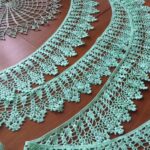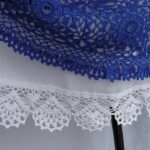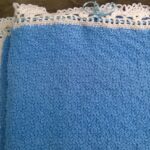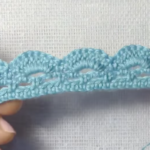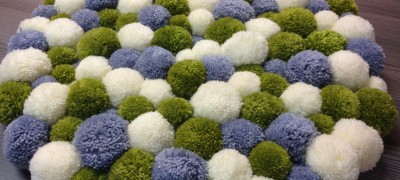How to crochet a blanket
A knitted blanket in the interior is not uncommon today. It's no secret that hand-made things make any design exclusive, fill the room with coziness and warmth. And the binding of each blanket is a kind of "cherry on the cake". Even the most ordinary blanket with a spectacular finishing chord - a beautiful binding - will become an accent in the interior. How to tie a blanket? Which thread to choose? And which scheme to give preference to?
What is a border, where is it applied
According to the definition, a border is a strip along the edge of a product (object, fabric), which differs in color, pattern and texture.
Crochet blanket border can be of different widths, it all depends on your personal desire. The most common item, sewn or knitted, can be brought to life and made unique with a regular crochet hook.

Most often, this finishing method is used for:
- Scarf, scarves, shawls.
- Handkerchiefs.
- Dresses, blouses, skirts, sleeves.
- Rushnikov, tablecloths.
- Plaids, bedspreads, capes.
And this is not a complete list. By and large, virtually all home textiles can be complemented with eye-catching edge trims. The main thing is that it is combined with the style of the interior as a whole.
The strapping can be performed immediately along the perimeter of the entire product (in a circle), or it can be done in a transverse design, especially when it comes to the "teeth" border. A border of individual motifs is possible, which are connected during the knitting process. Such a finish can be done with a denser pattern, or, conversely, be completely airy and light.

Thanks to the fillet knitting technique, you can create a real masterpiece from geometric elements or floral images.

The way to create an openwork edge of the product can also be different. Someone prefers to knit the border separately, and then carefully sew it to the finished product. And for others, the option is more preferable when the trim is knitted immediately on the product, the loops are typed along the edge of the finished blanket, dress or skirt. Immediately, we note that this does not affect the general appearance if the border is made neatly.
An important point: the border is quite capable of giving a second life to some things. For example, if it happens that the dress is too short (say, due to improper heat treatment), it is possible to “add” the missing centimeters with the help of a border. The same goes for the length of the sleeves. And an overly open neckline can be skillfully "hidden" behind a spectacular openwork.
Moreover, a correctly executed border fixes the shape of the product, does not allow the edges to bend (this is especially true in the case of products made with the front satin stitch), allows you to hide flaws (for example, seams), decorates, renews boring clothes.
What threads to use
The choice of threads for tying directly depends on the material of the product that you plan to design. Too thin threads will make the border not an effective addition, but an incomprehensible continuation of the product. Too thick yarn will easily ruin the edge of the thing (holes will appear very quickly under the weight of the thread). In addition, too coarse strapping is guaranteed to spoil the appearance, depriving the product of sophistication and elegance.

Wool, cotton, linen, rayon, man-made and blended fibers are most commonly used for tying. And remember, if the blanket is knitted with knitting needles No. 3, then using hook No. 3 for tying will be wrong, use a thinner tool, since the crochet fabric turns out to be somewhat coarser. It is for this reason that needlewomen do not often use yarn of the same thickness for the main fabric with knitting needles and for crocheting.
And in the case when both the main fabric and the strapping are crocheted, you can choose the thickness of the yarn and the tool at your discretion.
TOP 5 spectacular ideas
Of course, each needlewoman herself chooses the strapping option. Let's list the most popular ones.
Rach step
This method of processing the edge cannot be called one hundred percent edging, but it occupies almost a leading position in terms of polarity of use.

Its peculiarity lies in the fact that it is performed, as it were, backwards. Every self-respecting needlewoman knows at least three options for performing this method of edge processing: classic, with a crochet, double-sided.

Rach step is guaranteed to protect the blanket from deformation, and will ensure long-term operation of the product.
Pompons
Looking for an original and beautiful binding option - pompons are at your service. By the way, in this way you can effectively design not only a blanket, but also a scarf or stole.
Perhaps, before proceeding with the main pattern, the edge of the product will have to be tied with single crochet posts, which will allow to align the edge and give it rigidity.

Pom-pom binding starts from the corner of the product and continues along the entire perimeter.
Openwork binding
This is where the creative imagination of any needlewoman can roam! To begin with, the edge is tied with double crochets. Thus, you can give rigidity to the edge and facilitate the process of subsequent processing, since it is much easier to knit on an already started fabric.
The drawing itself can consist only of arches of air loops, of "crowns", leaves, beloved by many "pineapples" and much more. An abundance of schemes to help you.
Sinks
Shells or scallops, as they are also called, do not belong to the openwork processing of the edge. Rather, this finish will add stiffness to an overly airy canvas. Such a strapping consists of several double crochets with a common base.
Fillet edge
The most common finish for towels and tablecloths. Often done with natural colored threads. Even the usual "mesh" or "checkerboard" will decorate home textiles in a dignified manner. If a wider border is conceived, then the embodiment of a wide variety of patterns is possible on it.
For finishing blankets, a classic sirloin net is usually used.
Crocheting a blanket is a prerequisite for a stylish interior accessory. And even if you consider yourself a novice needlewomen, believe me, you can turn ordinary home textiles into an exclusive piece of furniture.
Video: crocheting a blanket


